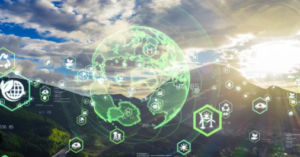Innovations in Environmental Management Technology

The junction of environmental management and technology has grown ever more important in recent years. Innovative technologies are becoming increasingly effective tools to handle urgent problems as the globe deals with climate change, resource depletion, and biodiversity loss. This paper investigates several technical developments changing environmental management, their uses, and their future possibilities.
Technology’s Involvement in Environmental Management
Knowing Environmental Control
Environmental management is the set of actions and methods meant to preserve and enhance the natural surroundings. It covers several techniques like sustainable development, pollution management, and resource economy. As technology develops, conventional approaches are being improved, so producing more effective management plans.
Why Technology Counts
One cannot stress the value of technology in environmental management. It offers fixes for data collecting, operations simplification, and decision-making facilitation. Using technology can help companies more successfully reach sustainability objectives and react to environmental issues with more agility.
Data Collection and Analysis Innovation
Technology of Remote Sensing
Data collecting on the environment has been transformed by remote sensing technologies. From a distance, researchers can track land usage, deforestation, water quality, and more using satellites and aerial photography. Timeliness of decision-making depends on real-time data collecting made possible by this technology.
Case Study: Surveillance of Deforestation
For example, satellites images are used on sites like Global Forest Watch to offer current data on changes in forest cover all around. This instrument enables governments and non-governmental organizations to intervene against forest destruction and illegal logging.
Geographic Information Systems, or GIS
Through its capacity to visualize and analyze spatial data, Geographic Information Systems (GIS) are indispensable in environmental management. GIS tools assist in environmental resource mapping, risk assessment, and planning of conservation initiatives.
Application Example: Urban Design
GIS can support sustainable development, help to locate green areas, and evaluate environmental effects in urban planning. By means of GIS, cities can design more effective waste management systems and enhance public transit paths, therefore lowering their carbon footprint.
The effect of artificial intelligence
AI in Environmental Surveillance
In environmental management artificial intelligence (AI) has become a revolutionary tool. Analyzing enormous volumes of data allows artificial intelligence to spot trends, project results, and offer practical insights.
Forecasting Analytics for Climate Change
AI models, for instance, can forecast effects of climate change on certain areas, therefore enabling proactive responses. These forecasts can influence resource allocation for strategies of climate adaption and help to shape policy decisions.
Intelligent Agriculture
Artificial intelligence tools are improving resource management in agriculture. Driven by artificial intelligence, precision farming makes use of soil condition, weather pattern, and crop health data to maximize resource use.
AI’s advantages for agriculture
Along with raising crop yields, this method reduces waste and environmental effect. Farmers may more effectively apply fertilizers and pesticides using AI-driven technologies, therefore lowering runoff and maintaining biodiversity.
The function of blockchain technology
Openness and responsibility
Blockchain technology’s capacity to offer responsibility and openness is helping it to become popular in environmental management. Blockchain guarantees that environmental data is tamper-proof and safe by building unchangeable records.
Use in Supply- Chains
Supply chain management is among the most exciting uses for blockchains. Monitoring the sources of items helps businesses to guarantee sustainable material procurement. This openness motivates companies to use environmentally friendly methods and helps customers choose wisely.
trading carbon credits
Blockchain also makes carbon credit trading possible, therefore enabling businesses to readily purchase and sell carbon credits. This invention gives companies financial motivation to lower their carbon emissions and make sustainable practice investments.

Innovations in Renewable Energy
Technologies Inspired by Solar Energy
Sustaining environmental management depends on a change toward renewable energy. Affordable and increasingly efficient are solar energy technologies like solar thermal systems and photovoltaic panels.
Integration with Smart Grids
Furthermore improving energy management is combining solar energy with smart grid technologies. By best distributing energy, smart grids help to lower waste and guarantee efficient use of renewable energy sources.
Development in Wind Energy
With bigger and more effective turbines being built, wind energy has also witnessed notable developments. Particularly offshore wind farms have great capacity to create pure energy.
Benefits to the Community
Apart from helping to lower greenhouse gas emissions, these developments generate employment possibilities and strengthen local businesses.
Techniques for Water Management
Intelligent Water Control Systems
A increasing global issue of water shortage makes effective water management absolutely vital. Using sensors and IoT technology, smart water management systems track water consumption and instantly identify leakage.
Ad advantages of smart technology
Analyzing this information helps municipalities to maximize their water distribution systems, therefore lowering waste and enhancing access to pure water.
Innovations in desalination
Still another vital field of invention is desalination technology. Energy-efficient techniques and membrane technology improvements make it more practical to turn saltwater into drinkable water.
Dealing with Water Scarce
Desalination could be quite important in guaranteeing water security for sensitive areas as climate change keeps affecting freshwater supplies.
Methods of Waste Management
Circular Economy and Waste Reduction:
A circular economy’s idea stresses on material repurposing and waste reduction. Better trash tracking and recycling techniques made possible by technology help to enable this change.
clever garbage cans
Smart waste bins with sensors, for instance, may track fill levels and maximize collecting paths, therefore lowering the fuel consumption and emissions related to waste movement.
technologies for waste-to energy conversion
Waste-to energy systems generate renewable energy and simultaneously help to reduce non-recyclable waste by converting it into electricity. These developments support a more environmentally friendly waste control mechanism.
Conservation of Biodiversity Technologies
Conservation Using Drones
Conservation of biodiversity is benefiting much from drones’ great utility. Their fast and effective coverage of big areas lets one monitor environments, animal populations, and illicit activity including poaching.
For instance, anti-poaching initiatives
Drones are used, for example, by groups such as the World Wildlife Fund (WWF) to monitor protected areas and compile information that guides conservation plans and strengthens security initiatives.
Genetic Devices
Developments in genetic technology, such CRISpen, present fascinating opportunities for preservation of biodiversity. These instruments allow one to rebuild ecosystems and improve the resilience of threatened species.
Moral Aspects
But the application of genetic technologies begs moral issues that have to be given great thought. Ensuring that these technologies benefit the society as a whole depends on striking a balance between creativity and ethical obligation.
Environmental Management Technologies: Their Prospect
Combining Technologies for Increased Effectiveness
Integration of several technologies will define environmental management going forward. Combining data analytics, artificial intelligence, blockchain, and renewable energy can help companies provide complete solutions addressing several environmental issues concurrently.
Teamwork Efforts
Harnessing the full promise of these technologies will depend on cooperation among governments, companies, and communities. Including involved stakeholders in decision-making procedures helps to produce more fair and sustainable results.
Awareness and Education
As technology develops, acceptance of it will depend much on awareness and education as well as on its evolution. Public awareness campaigns and training initiatives help people and companies to properly apply technology in environmental management.
Finally
Ultimately, developments in technology are profoundly changing environmental management. From data collecting and analysis to sustainable energy sources, there is great possibility for good influence. Accepting these technologies and encouraging teamwork will help us to build a more sustainable future for our earth. Incorporating creative methods and techniques is not just a trend but also a need given the environmental problems of our day. Ensuring a better planet for next generations depends on a dedication to sustainability and responsible technology use going ahead.